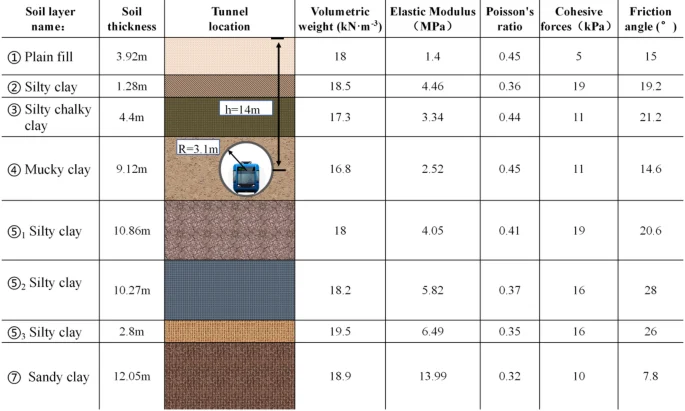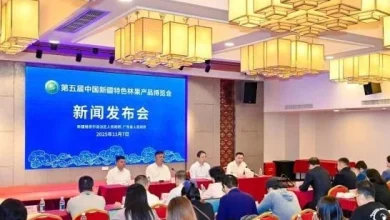Long term settlement of twin subway tunnels induced by train loads under passenger flow variation

Foundation soil cumulative deformation calculation model
Tunnel settlement under subway loads generally comprises two components: cumulative plastic strain of the foundation soil and consolidation settlement resulting from the dissipation of excess pore water pressure. The hierarchical sum method4 is employed to calculate the long-term settlement characteristics of the tunnel, derived from the dynamic deviatoric stress response results in the model analysis.
The total settlement, SQ, of the foundation soil during long-term train operations can be expressed by Eq. (3):
$${S_Q}={S_p}+{S_u}$$
(3)
Where Sp represents the settlement due to cumulative strain in the soil, and Su denotes the consolidation settlement caused by the dissipation of excess pore water pressure, each calculated by Eq. (4):
$$\left\{ {\begin{array}{*{20}{c}} {{S_p}=\mathop \sum \limits_{{i=1}}^{n} \varepsilon _{i}^{p}{h_i}} \\ {{S_u}=\mathop \sum \limits_{{i=1}}^{n} m{v_r}u_{i}^{p}{h_i}{U_i}} \end{array}} \right.$$
(4)
Where n is the number of soil layers; hi is the thickness of the soil layer i; εip is the cumulative plastic deformation of soil in layer i; mvi is the volume compression coefficient of soil in layer i; uip is the excess pore water pressures of soil in layer i; and Ui is the degree of consolidation of soil in layer i, assumed to be 100%.
Calculation model of cumulative strain and cumulative pore pressure
Under subway loads, the cumulative strain characteristics of clayey soils in Shanghai are well-described by the cumulative plastic strain model (Eq. 5)36,37, while the development of pore pressure in saturated soft clay is accurately simulated by Eq. (6)38:
$${\varepsilon ^p}=aD_{d}^{m}{\left( {\frac{p}{{{p_a}}}} \right)^c}{N^b}$$
(5)
$$u={a_n}{n_u}D_{d}^{*}{\left( {\frac{p}{{{p_a}}}} \right)^{{c_u}}}{p_a}{N^{{b_u}}}$$
(6)
Where the parameters a, m, c, b, au, nu, cu, and bu are model constants derived from fitting the results of dynamic triaxial tests. Here, P represents the initial average consolidation stress, with Pa = 101 kPa. Dd is the dynamic deviatoric stress level, calculated as Dd=qd/qult, where qd is the dynamic deviatoric stress, and quit is the undrained shear strength obtained from Eq. (7).
$${q_{uit}}=M{p_c}{\left( {\frac{{M+\alpha }}{{2M}}} \right)^{\frac{{\lambda – \kappa }}{\lambda }}}$$
(7)
Where M is the critical state stress ratio, while λ and κ are the slopes of the normal consolidation line and the rebound line in the e-lnp space, respectively. Under isotropic consolidation, α = 0 and pc=p. For biased consolidation, pc is derived from the initial consolidation pressure and the initial biased stress using the boundary surface equation.
The parameters for the cumulative plastic strain model and the cumulative pore water pressure development model for soft soils in Shanghai are listed in Table 426,39,40.
Table 4 Model parameters.
Cumulative settlement calculation model
During the long-term operation of the subway, the fluctuations in subway load caused by changes in passenger flow are significant and cannot be ignored. However, the conventional model (Eq. 3) only accounts for the long-term settlement of the tunnel under static operating conditions. It does not consider the varying impact of passenger flow on tunnel settlement in real-world projects, nor does it address the effects of repeated vibrations caused by trains passing in opposite directions. To address these limitations, the dynamic deviatoric stress is initially categorized into four operating conditions based on the pattern of passenger flow: full-load, high-load, medium-load, and low-load periods. Using the principles of differentiation and superposition, settlement prediction equations are derived for both beneath the tunnel and at the symmetry center of the two tunnels.
Settlement of soil below the tunnel
When calculating the settlement at the base of the tunnel, it is sufficient to consider only the impact of the train traveling directly above and disregard the dynamic response from trains in the opposite tunnel.
The calculation procedure is as follows:
First, account for the effects of changes in passenger capacity. After operating for M days, the cumulative plastic strain induced by subway operations is categorized into the four aforementioned operating conditions. This is expressed in Eq. (8):
$$\varepsilon _{Q}^{p}=\varepsilon _{{QF}}^{p}+\varepsilon _{{QJ}}^{p}+\varepsilon _{{QK}}^{p}+\varepsilon _{{QL}}^{p}=\mathop \smallint \limits_{1}^{{MHt}} d{\varepsilon ^p}dN=\varepsilon _{{Q1}}^{p}+\varepsilon _{{Q2}}^{p}+\varepsilon _{{Q3}}^{p}+…+\varepsilon _{{Qm}}^{p}$$
(8)
Where εpQF, εpQJ, εpQK, εpQK represent the settlements for full-load, high-load, medium-load, and low-load periods, respectively, which can be calculated using Eq. (9); εpQ1, εpQ2, εpQ3, … εpQm, are the strains induced by subway operations on days 1, 2, 3, … m, respectively.
$$\left\{ \begin{gathered} \varepsilon _{{QF}}^{p}=\sum\nolimits_{{r=1}}^{Z} {\varepsilon _{{rF}}^{p}=\int_{1}^{{ft}} d {\varepsilon ^p}dN+\int_{{Ht+1}}^{{\left( {f+H} \right)t}} d {\varepsilon ^p}dN+…+\int_{{(M – 1)Ht+1}}^{{\left[ {\left( {M – 1} \right)H+f} \right]t}} d {\varepsilon ^p}dN} \hfill \\ \varepsilon _{{QJ}}^{p}=\sum\nolimits_{{r=1}}^{Z} {\varepsilon _{{rJ}}^{p}=\int_{{ft+1}}^{{\left( {f+j} \right)t}} d {\varepsilon ^p}dN+\int_{{\left( {f+H} \right)t+1}}^{{\left( {f+j+H} \right)t}} d {\varepsilon ^p}dN+…+\int_{{\left[ {\left( {M – 1} \right)H+f} \right]t+1}}^{{\left[ {\left( {M – 1} \right)H+f+j} \right]t}} d {\varepsilon ^p}dN} \hfill \\ \varepsilon _{{QK}}^{p}=\sum\nolimits_{i}^{n} {\varepsilon _{k}^{p}{h_i}=\int_{{\left( {f+j} \right)t+1}}^{{\left( {f+j+k} \right)t}} d {\varepsilon ^p}dN+\int_{{\left( {f+j+H} \right)t+1}}^{{\left( {f+j+k+H} \right)t}} d {\varepsilon ^p}dN+…+\int_{{\left[ {\left( {M – 1} \right)H+f+j} \right]t+1}}^{{\left[ {\left( {M – 1} \right)H+f+j+k} \right]t}} d {\varepsilon ^p}dN} \hfill \\ \varepsilon _{{QL}}^{p}=\sum\nolimits_{i}^{n} {\varepsilon _{l}^{p}{h_i}=\int_{{\left( {f+j+k} \right)t+1}}^{{Ht}} {d{\varepsilon ^p}} dN+\int_{{\left( {f+j+k+H} \right)t+1}}^{{2Ht}} {d{\varepsilon ^p}} dN+…+\int_{{\left[ {\left( {M – 1} \right)H+f+j+k} \right]t+1}}^{{MHt}} {d{\varepsilon ^p}} dN} \hfill \\ \end{gathered} \right.$$
(9)
Where t is the number of vibrations for each train operation, t = 1222; H is the total number of train runs per day, expressed as H = f + j + k + l; f, j, k, l represent the number of runs during full-load, high-load, medium-load, and low-load periods, respectively.
Similarly, the development of excess pore water pressure can be described by Eq. (10):
$${u_Q}={u_{QF}}+{u_{QJ}}+{u_{QK}}+{u_{QL}}=\mathop \smallint \limits_{1}^{{MHt}} dudN={u_{Q1}}+{u_{Q2}}+{u_{Q3}}+…+{u_{QM}}$$
(10)
Where uQF, uQJ, uQK, uQK are the excess pore water pressures caused by full-load, high-load, medium-load, and low-load periods, respectively; uQ1, uQ2, uQ3, … uQM are the excess pore water pressures resulting from subway operations on days 1, 2, 3, … m, respectively.
In conclusion, the total settlement SQ induced after M days of operation can be quantified by Eq. (11).
$${S_Q}=S_{Q}^{p}+S_{Q}^{u}=\mathop \sum \limits_{i}^{n} m{v_i}{h_i}{U_i}\left( {{u_{QF}}+{u_{QJ}}+{u_{QK}}+{u_{QL}}} \right)+\mathop \sum \limits_{i}^{n} {h_i}\left( {\varepsilon _{{QF}}^{p}+\varepsilon _{{QJ}}^{p}+\varepsilon _{{QK}}^{p}+\varepsilon _{{QL}}^{p}} \right)$$
(11)
Calculation of soil settlement at the center of symmetry
The center of symmetry between two tunnels is subject to repetitive vibrations from trains on both the left and right sides. This results in the soil experiencing twice the number of vibrations compared to the soil directly beneath a single tunnel. Consequently, the total settlement ScQ at the center of symmetry is divided into two components: SrQ, the settlement caused by train operations on the left side, and SlQ, the settlement caused by the right side, as detailed in Eq. (12):
$${S_{cQ}}={S_{rQ}}+{S_{lQ}}$$
(12)
Assuming the operations of the left and right trains alternate, the cumulative plastic strain in the soil at the center of symmetry can be described by Eq. (13):
$$\varepsilon _{{cQ}}^{p}=\varepsilon _{{rQ}}^{p}+\varepsilon _{{lQ}}^{p}=\mathop \smallint \limits_{1}^{{2MHt}} d{\varepsilon ^p}dN=\varepsilon _{{cQ1}}^{p}+\varepsilon _{{cQ2}}^{p}+\varepsilon _{{cQ3}}^{p}+…+\varepsilon _{{cQM}}^{p}$$
(13)
Where εprQF and εplQF represent the strains caused by the operations of the left and right subway trains, respectively; εpcQ1, εpcQ2, εpcQ3, … εpcQM are the strains caused by subway operations on days 1, 2, 3, …, m, respectively. These can be calculated using Eq. (14).
Taking the strain εpcQa on day ɑ as an example, the plasticity dependent variable for this day can be calculated from Eq. (14):
$$\varepsilon _{{cQa}}^{p}=\mathop \smallint \limits_{{2\left( {a – 1} \right)Ht+1}}^{{2aHt}} d{\varepsilon ^p}dN$$
(14)
Similarly, the development of excess pore water pressure is modeled by Eq. (15):
$${u_{cQ}}={u_{rQ}}+{u_{lQ}}=\mathop \smallint \limits_{1}^{{2MHt}} dudN={u_{cQ1}}+{u_{cQ2}}+{u_{cQ3}}+…+{u_{cQM}}$$
(15)
Where urQ and ulQ are the excess pore water pressures caused by the operations of the left and right subway trains, respectively; ucQ1, ucQ2, ucQ3, … ucQM are the excess pore water pressures induced by train operations on days 1, 2, 3, …, m, respectively, and can be calculated in reference to Eq. (14).
The total settlement ScQ induced at the center of symmetry after M days of operation is then expressed by Eq. (16):
$${S_{cQ}}=S_{{cQ}}^{p}+S_{{cQ}}^{u}=\mathop \sum \limits_{i}^{n} {h_i}\left( {\varepsilon _{{rQ}}^{p}+\varepsilon _{{lQ}}^{p}} \right)+\mathop \sum \limits_{i}^{n} m{v_i}{h_i}{U_i}\left( {{u_{rQ}}+{u_{lQ}}} \right)$$
(16)
Reliability verification of the differential settlement prediction model
Using Shanghai Metro Line 127 and Wuxi Metro Line 135 as examples, we verified the reliability of the differential settlement prediction model. The results, as presented in Fig. 13, demonstrate that the Mean Square Error (MSE) for the differential prediction model in Shanghai Subway Line 1 and Wuxi Subway Line 1 are 5.30 and 0.47, respectively. These figures are significantly lower than those of the conventional model, which are 12.12 and 0.92, respectively. Consequently, it is evident that the differential settlement prediction model is more accurate than the conventional model, and it is suitable for long-term settlement predictions of tunnels.
Fig. 13
Long-term settlement prediction for the tunnel.




